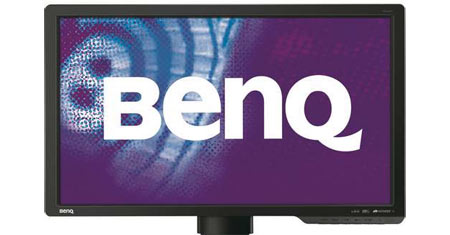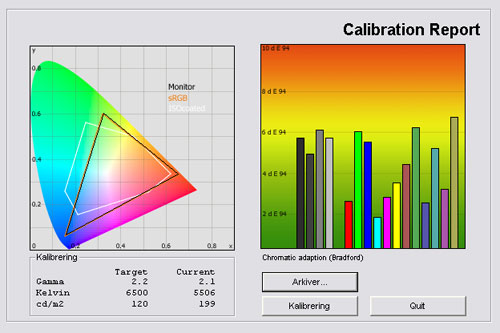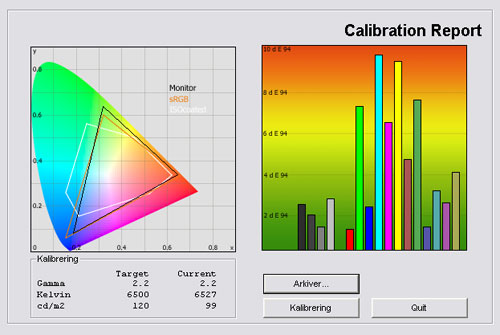Review: BenQ XL2410T
BenQ XL2410T review
BenQ has released their first 120 Hz monitor called XL2410T, and even though BenQ is late, XL2410T looks like an interesting addition to the 120 Hz market. XL2410T has 1920x1080 resolution and the 120 Hz TN panel also enables 3D-gaming. Furthermore BenQ says that XL2410T has also been developed in collaboration with two professional Counter-Strike players, for optimal performance.
But is BenQ XL2410T as good as the other 120 Hz monitors such as the LG W2363D and Samsung 2233rz? And what about input lag and 3D picture quality? Find out in this exclusive XL2410T review on FlatpanelsHD.
Subscribe to our Newsletter, RSS feed or twitter to receive notice when new reviews are online.
Size: 23.6" Wide Resolution: 1920x1080 Response time: 2 ms (g2g) Contrast ratio: 1000:1 Brightness: 300 cd/m2 Color support: Up to 16.2 million colors Signal processing: 6 bit for each color + FRC Viewing angles (H/V): 170/160 Dot pitch: 0.2715 Panel type: TN panel with LED Wall mounting: Dimensions (HxWxD): 34.7cm x 57.0cm x 6.3cm (without stand) Weight 6.37 kg Built-in speakers: Ergonomics Tilt Swivel Height Pivot Inputs VGA DVI DisplayPort Audio (type) (1 output)
S-video Composite Component HDMI (1 input)
Other Price and retailer:
| US retailer | UK retailer |
 |  |
Our first impressions
BenQ XL2410T has a typical black cabinet. The cabinet is made from matte plastic so you don’t have to worry about reflections from windows.The stand is rectangular and strong. BenQ XL2410T allows users to swivel, height and tilt adjust the monitor. XL2410T even has a pivot function.
Such extensive ergonomic adjustability is not standard on gaming monitors today and I’m sure many users will appreciate the added flexibility.
Inputs have been integrated at the back of the monitor and below you see DVI, D-SUB (VGA) and HDMI inputs. On the side of the monitor we found a headphone jack.
Buttons are located on the right side of the frame along with some pretty logos.
A PBP function (Picture by Picture) is also available and you can combine DVI/HDMI and HDMI/VGA, but not DVI/VGA.
BenQ XL2410T also comes bundled with some Zowie equipment. See the picture below.
In the menus BenQ XL2410T has the following picture setting options: brightness, contrast, sharpness, color (RGB, only in user-game modes), AMA (overdrive), Instant mode, Dynamic contrast, and Color Format.
You can also select from these picture presets: Movie, Photo, sRGB, Eco, Standard, FPS, User Game-1, User Game-2.
Energy Consumption
Below I have measured energy consumption on BenQ XL2410T. |  | |
| Standby | 0.5 W | 0.5 W |
| PC | 32 W | 24 W |
After calibration I measured energy consumption to 24 W which is lower than on LG W2363D and the primary reason is the LED backlight. Stand-by consumption was measured to 0.5 W.
Also, please note that LCD monitors uses less power after calibration. This is common on flat panel displays because many picture parameters are reduced during calibration.
Test tools
We use the DVI input for testing. The graphic card is Geforce GTX260.The monitor has been measured and calibrated with a LaCie Blue Eye Pro. We also examine the monitor with the help of our monitorTest. And finally we test the monitor in games, movies etc.
Picture quality on BenQ XL2410T
Out-of-box picture quality on BenQ XL2410T is measured below in the default picture preset called FPS.The graph says this:
The number on the left is the delta value. Delta is a difference between two factors; here it’s the difference between the measured color on the panel and the actual color that is our target.
The out-of-box picture characteristics are bad. I measured huge colors deviations, mainly because gamma was far too low rising from 1.22 in bright shades to 1.76 in dark shades.
In practice this means that pretty much all colors are too bright and saturated, and even though it’s a common trick to boost picture elements, the deviations are extreme on XL2410T. You can also see that color deviations are significant in the graph above.
Color temperature is slightly too low resulting in slightly too reddish pictures. Brightness was measured to 236 cd/m2 which is optimal for gaming in bright environments.
Obviously I wanted to improve picture quality on XL2410T so I switched to the sRGB preset on XL2410T and took a new measurement.
The sRGB mode is far better but not perfect. Gamma is rising from 1.75 in the bright grey tones to 2.36 in the dark grey tones. This means that the dark shades are too dark and the bright shades are too bright but pictures are definitely more natural and balanced in the sRGB mode.
The graph suggests that color deviations are moderate, and this is true, but color temperature is too low compared to our 6500 Kelvin target.
The sRGB picture preset is acceptable for a gaming monitor but I wanted to improve picture quality so went on to do a calibration on XL2410T. Below you can see my results.
Unfortunately you need to switch to the Custom mode (called User Game-1 or User Game-2) if you want to adjust RGB settings. These settings are locked in the sRGB preset – and all other presets. And because the Custom mode exhibited very extreme picture settings similar to the FPS mode, I never reached a very pleasing calibrated result. As you can see the color deviations are visible, even though I reached a 2.2 gamma and 6527 Kelvin color temperature.
Notice that the Custom mode has a skewed color gamut (the left graph) compared to our target value. This was not the case in the sRGB mode and I wish BenQ would have allowed us to change color parameters in other presets than the Custom preset.
Actually this is strange because many previous BenQ monitors has natural and balanced picture settings that we have often praised.
My calibrated settings are:
 | |
| Picture preset: | sRGB |
| Brightness | 35 |
| Contrast | 50 |
| Sharpness: | 3 |
| Gamma: | 2.2 |
| AMA: | On |
| Instant mode: | On |
As mentioned before, I advise you to use the sRGB mode. Even though you have access to RGB settings in the User Game modes, you will get better results with the sRGB mode with more natural and balanced picture quality.
I moved on to examine XL2410T in practical use and the first thing I noticed was that XL2410T has a matte panel which reduces reflections from windows and lamps. The matte bezel shows no distracting reflections either which is positive.
I went on to examine color gradation – how well the monitor distinguishes the different colors. We examine color gradation with smooth gradients – for example smooth red to black gradients - and we aim for a perfectly smooth gradient without “bands”.
BenQ XL2410T has some problems with reproducing our gradients and I saw bands in the dark and semi-dark colors, which means that not all colors are perfectly distinguished. This is typical for gaming monitors and we saw a similar result on for example Samsung 2233rz but compared to the IPS and VA panels, the difference is definitely noticeable, and BenQ XL2410T is not suited for color critical work and photograph work.
Below I have measured black level, brightness and contrast ratio.
 |  | |
| Black level | 0.27 cd/m2 | 0.13 cd/m2 |
| Brightness | 236 cd/m2 | 99 cd/m2 |
| Contrast ratio | 874:1 | 762:1 |
Contrast ratio +/- 50
After calibration I measured a black depth of 0.13 cd/m2 at a peak brightness level of 99 cd/m2, optimized for viewing in dark rooms. This is a good result and better than what we measured on LG W2363D and Alienware AW2310 but on par with Asus VG236H.
However, compared to the best VA based panels such as the Eizo EV2333H, the TN panels are still behind. On EV2333H we measured a black level of 0.04 cd/m2.
Obviously 99 cd/m2 brightness is too low for 3D gaming so here you probably want to increase the backlight intensity which also means that the black level rises.
Shadow detailing on BenQ XL2410T is fair but not great. The 3-4 darkest grey tones in the sRGB preset are crushed and reproduced as black. This means that you. lose some details in dark colors in games and movies.
Lastly I examined XL2410T in a completely dark room to see if the panel has clouding / backlight bleeding issues; often seen on lower priced TN based monitors but also most common on most LCD monitors based on IPS and VA panels.
My BenQ XL2410T sample has some bleeding along the bottom edge of the panel and some very minor bleeding in the two top corners. Unfortunately this is visible in movies and games.
Response time and games
Response time is important but 120 Hz is probably a more significant improvement for gamers. If you’re looking for a 120 Hz monitor you probably already know the benefits of 120 Hz panels such as faster response and smoother pictures. For more information on the 120 Hz technology see former reviews such as the LG W2363D review.The same is true for BenQ XL2410T. The 120 Hz greatly improves gaming performance. Response time on BenQ XL2410T is generally good and I saw very minor blurring in gaming and movies. Response time is also close to constant on dark and bright color transitions which means that you’ll experience the same amount of blurring in dark and bright games. The TN panel is also still the fastest LCD panel technology and is preferred for gaming.
I did see some overdrive trailing, however. It was easy to see in our stress tests but I also saw it a few times dark games. Overdrive trailing is different that traditional trailing because of its halo-like trailing effect around moving objects.
XL2410T uses a so-called AMA circuit which is basically an Overdrive controller. Be default AMA is activated but no further setting options are available. If you deactivate AMA, overdrive trailing is eliminated, but traditional trailing is greatly reduced. Therefore I advise you to activate AMA.
Another important aspect of gaming is input lag. My tests gave me some very good input lag results on BenQ XL2410T but I wanted to confirm these in a side-by-side comparison test so I tried to compare XL2410T with LG W2363D with the help of a DVI splitter.
BenQ XL2410T has a so-called Instant Mode similar to the Thru mode on LG W2363D. These modes aims to reduce input lag to zero milliseconds.
Below you see two comparisons of the two monitor with the thru-modes enabled taken with a Canon EOS with fast shutter time and high ISO. As you can see the pictures are perfectly synced, and because our reference W2363D is already proven to have 0 ms input lag, BenQ XL2410T has 0 ms input lag, too.

BenQ XL2410T left vs. LG W2363D right
I tried to switch off the Thru-mode on the LG W2363D. As you can see BenQ XL2410T is now 20 ms faster.

BenQ XL2410T left vs. LG W2363D right
The instant mode is available in all the different color presets on XL2410T.
3D picture quality on BenQ XL2410T
I’m not going to say much about 3D picture quality and the 3D experience in general, and if you want detailed information about 3D gaming on 3D PC monitors, please see the Alienware AW2310 review here. I used the same Nvidia 3D Vision system to test BenQ XL2410T.BenQ XL2410T is not much different from Alienware AW2301T. I still feel that the LCD technology is a bit too slow for perfect 3D picture quality and every 3D LCD monitor on the market today has some crosstalk issues.
3D gaming is perfectly possible on XL2410T and the panel has a high maximum brightness level which is adequate for 3D gaming with 3D glasses. But as said, I did notice crosstalk in most games and I think manufacturers need to work on scanning backlight systems to reduce crosstalk on LCD monitors.
Viewing angles
The viewing angles are not very wide and color intensity is reduced significantly from angles. From the sides colors are darker and from the top the panel looks washed out.The black level is reduced and gets a tint from wide angles, too. See the picture below.
Conclusion
BenQ XL2410T has a matte, black frame and extensive ergonomic adjustability which is great. The monitor feels robust and the integrated HDMI input allow users to connect other devices, although it’s not a HDMI 1.4 input. A PBP (Picture by picture) function has been integrated and XL2410T also comes bundled with some Zowie equipment.The default picture preset called FPS had too extreme picture characteristics and the out-of-box picture quality wasn’t very good. The sRGB preset has a far more natural and balanced colors but no RGB settings. To adjust RGB settings you need to use the User Game-1 or User Game-2 presets and these are also too extreme and oversaturated, so I advise you to use the sRGB mode on XL2410T.
Color reproduction is fair but not great. Black level is one of the best we have measured on a 120 Hz TN based monitor but unfortunately our XL2410T sample had some backlight bleeding at the bottom of the panel and black was also visibly reduced from wide angles because of the narrow viewing angles.
The gaming performance is great. The 120 Hz panel creates a smooth and responsive gaming experience and our input lag tests revealed that XL2410T has no input lag issues because of the Instant mode that is comparable to the Thru mode on LG W2363D. XL2410T has almost zero blurring on fast motion but unfortunately we did experience some overdrive trailing.
All in all BenQ Xl2410T has top notch gaming performance with only the overdrive trailing being a point of criticism. On the other hand color characteristics are not very impressive. We had also hoped for better viewing angles and less backlight bleeding, and in a direct comparison I actually think the LG W2363D is a better overall choice.
Price and retailer:
| US retailer | UK retailer |
 |  |
 |  |  |
| 120 Hz panel | Out-of-box picture quality | Gaming |
| Black level | Backlight bleeding | Multimedia |
| Ergonomic stand and matte bezel | Viewing angles and black from wide angles | |
| Response time | Overdrive trailing | |
| No input lag | No RGB setting option in sRGB mode | |
| Shadow details crushed in games |
















